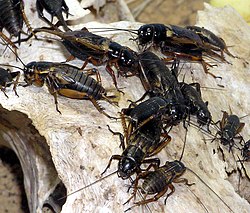Cricket (insect)
Crickets, family Gryllidae (also known as true crickets), are insects that are closely related to katydids or bush crickets (family Tettigoniidae). They have somewhat flattened bodies and long antennae. There are about 900 species of crickets. They tend to be nocturnal. Crickets are often confused with grasshoppers, which they are also related to, because they have a similar body structure including jumping hind legs.
| Cricket | |
|---|---|

| |
| A cricket | |
| Scientific classification | |
| Kingdom: | |
| Phylum: | |
| Class: | |
| Order: | |
| Suborder: | |
| Superfamily: | |
| Family: | Gryllidae Bolívar, 1878
|
Cricket chirping
Crickets are known for their chirp (which only male crickets can do; male wings have ridges or "teeth" that act like a "comb and file" instrument). The left forewing has a thick rib (a modified vein) which bears 50 to 300 "teeth". The chirp is made by raising their left forewing to a 45 degree angle and rubbing it against the upper hind edge of the right forewing, which has a thick scraper (Berenbaum 1995). This sound producing action is called "stridulation" and the song is species-specific. There are two types of cricket songs: a calling song and a courting song. The calling song attracts females and repels other males, and is fairly loud.
Jurassic chirp reconstructed
Night-time in the Jurassic included the sound of chirping bush crickets. This is according to scientists who have reconstructed the song of a cricket that chirped 165 million years ago. "A remarkably complete fossil of the prehistoric insect enabled the team to see the structures in its wings that rubbed together to make the sound".[1][2]
Cricket (insect) Media
A male Gryllus cricket chirping: Its head faces its burrow; the leathery fore wings (tegmina; singular "tegmen") are raised (clear of the more delicate hind wings) and are being scraped against each other (stridulation) to produce the song. The burrow acts as a resonator, amplifying the sound.
The calling song of a field cricket
Two adult domestic crickets, Acheta domesticus, feeding on carrot
Various instars of Gryllus assimilis, by Robert Evans Snodgrass, 1930
Crickets are reared as food for pets and zoo animals like this baboon spider, Pterinochilus murinus, emerging from its den to feed.
Cretaceous fossil cricket from Brazil
Il Grillo Parlante (The Talking Cricket) illustrated by Enrico Mazzanti for Carlo Collodi's 1883 children's book "Le avventure di Pinocchio" (The Adventures of Pinocchio)
Meiji period cricket holder in the form of a norimono palanquin, c. 1850
References
- ↑ Gill, Victoria 2012. Jurassic cricket's song recreated. BBC Nature. [1] Archived 2012-02-07 at the Wayback Machine
- ↑ Jun-Ji Gu et al. 2012. Wing stridulation in a Jurassic katydid (Insecta, Orthoptera) produced low-pitched musical calls to attract females. PNAS [2] Archived 2012-02-10 at the Wayback Machine
Other websites
| Wikimedia Commons has media related to Lua error in Module:Commons_link at line 62: attempt to index field 'wikibase' (a nil value).. |
- Intro on house crickets
- How to raise your own crickets[dead link]
- Crickets in the Classroom
- Intro Information
Archived 2007-10-13 at the Wayback Machine drawings and activities
- [3] Archived 2010-09-24 at the Wayback Machine
- The cricket suicide (video) Archived 2009-09-03 at the Wayback Machine
- Singing Insects of North America Archived 2008-12-22 at the Wayback Machine An online field guide








